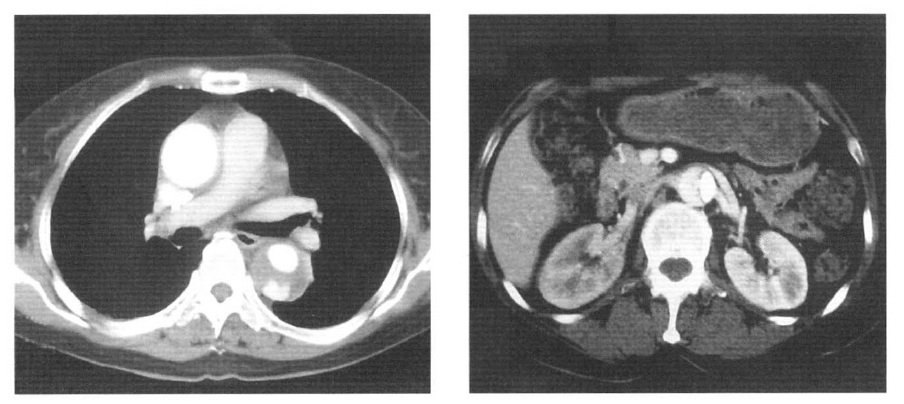INTRODUCTION
Disseminated intravascular coagulation (DIC) is a life-threatening complication of several disease states including sepsis, cancer, obstetrical complications, trauma and aortic aneurysm, although DIC associated with aortic aneurysm is rarely reported in Korea1, 2). The definitive treatment for DIC caused by an aortic dissecting aneurysm, involves lesion removal and the infusion of coagulation factors during the operation to minimize blood loss. We reported a case of DIC caused by an aortic dissecting aneurysm, which was resolved by non-surgical therapy.
CASE REPORT
A 55-year-old female patient was transferred from another hospital because of chest pain radiating to her back and thrombocytopenia. She had been diagnosed as having essential hypertension approximately 3 years earlier, but was not medicated. The chest pain developed upon exertion and radiated to her back the day prior to admission to a local hospital; it persisted and became more severe after admission. On admission, her temperature was 36.8°C, her pulse rate was 106, her respiration was 20, and her blood pressure was 190/100 mmHg. On physical examination, the patient appeared acutely ill, but her heart sounds were normal. A neurologic examination revealed no abnormalities. Laboratory test results are shown in Table 1. Urinalysis revealed many red blood cells and 0–5 white blood cells per high power field. Chest radiographs revealed mediastinal widening, and a computer tomography (CT) scan of the thorax and abdomen revealed a dissecting aneurysm of the descending thoracic aorta, which descended inferiorly to the proximal abdominal aorta (Figure 1). Medical treatment started immediately with the infusion of nitroprusside and esmolol. On the 2nd day of admission, the patient reported an improvement in her chest pain, and she had a platelet count of 63,000/mm3. On the 7th day, her platelet count was 377,000/mm3, and her prothrombin and partial-thromboplastin times were normal. We followed up the aortic dissecting aneurysm by a thorax CT on the same day and disease progression was not observed.
At 3 weeks after admission, her blood pressure and pulse rate had normalized and her chest pain had fully subsided. The DIC profiles, including platelet count, prothrombin and partial-thromboplastin times, D-dimer, FDP, antithrombin III, and fibrinogen, had normalized (Table 1). Outpatient follow-up by laboratory testing, thorax CT, and echocardiography have been performed at regular intervals over a period of 9 months, and the patient is doing well.
DISCUSSION
Disseminated intravascular coagulation (DIC) is a rare complication of aortic dissecting aneurysm, but a well-recognized one3). In the current series of patients with aortic aneurysm, 40% were found to have elevated levels of fibrinogen split products, but only 4% experienced significant bleeding and laboratory evidence of DIC4). The pathogenesis of coagulopathies, caused by aortic dissecting aneurysm, may be related to the release of endothelin, thromboplastin, and other attractants from the exposed subendothelial tissue and to the subsequent clot formation. DIC implies the consumption of platelets, fibrinogen, and coagulation factors because of extensive in vivo coagulation. The mechanical destruction of platelets as the blood flows over the thrombus may also play a role1, 3, 5)
There is no single laboratory test that can establish or rule out a diagnosis of DIC1, 6). In clinical practice, a DIC panel typically consists of a platelet count, a fibrinogen level, a prothrombin and a partial thromboplastin time, and a measurement of D-dimer (or FDP) level. Tests for D-dimers may be helpful in the differentiation of DIC from other conditions that are associated with a low platelet count or a prolonged clotting time. Quantitations of selected coagulation inhibitors, including antithrombin III and/or protein C, may provide useful prognostic information. A scoring system that uses simple laboratory tests has recently been published by the DIC subcommittee of the International Society on Thrombosis and Haemostasis6). A score of ≥ 5 was deemed compatible with a diagnosis of DIC, but the published scoring system has not yet been validated by prospective studies. In the present case, a low platelet count (<50,000/mm3, scoring 2), a moderately elevated FDP (20 μg/mL, scoring 2), and a low fibrinogen level (<1.0 g/L, scoring 1) were obtained, giving a total score of 5. On admission, the patient’s D-dimer level was elevated to 2.0 μg/mL and her anti-thrombin III level depressed to 19.7 mg/dL, which is compatible with overt DIC. Thus, we made a diagnosis of DIC associated with aortic dissecting aneurysm.
When these two conditions coexist, they create a difficult clinical problem that requires optimal medical and surgical care. The definitive treatment for DIC involves specific and vigorous treatment of the underlying cause1–3, 6). Surgical intervention is still the main strategy for normalizing coagulopathy7, 8). Bleeding diathesis must be corrected before surgery in order to prevent massive intraoperative bleeding. In this respect, if bleeding is brisk or surgery is contemplated, cryoprecipitate, platelet concentrates, and fresh-frozen plasma should be given; anti-thrombin III concentrate and gabexate may also be effective in some cases9). We recommended surgical intervention in the present case, but the patient refused, so we treated her using intravenous antihypertensive agents and antithrombin III replacement. After treatment, her clinical symptoms and DIC profiles improved. She was discharged without any complication, and has remained symptom-free and well during the 9 months since discharge.




 PDF Links
PDF Links PubReader
PubReader ePub Link
ePub Link Full text via DOI
Full text via DOI Download Citation
Download Citation Print
Print





